
- 1 Introduction: Tired of Sending Yourself the Same Files Over and Over?
- 2 1. Big Picture: What Exactly Can You Sync Between iPad and Windows?
- 3 2. Before You Start: Accounts and Apps You Should Have
- 4 3. Syncing Photos and Videos: iCloud vs. OneDrive
- 5 4. Sharing Files, PDFs, and Screenshots Between iPad and Windows
- 6 5. Syncing Notes and Office Documents
- 7 6. Syncing Browser Bookmarks and Tabs
- 8 7. Syncing Notifications and Small Text Snippets
- 9 8. Common Problems and How to Avoid Them
- 10 9. Example Workflow: A Day with iPad and Windows Working Together
- 11 10. Summary: Make Your Devices Work for You, Not Against You
Introduction: Tired of Sending Yourself the Same Files Over and Over?
Do you use a Windows laptop for work and an iPad for everything else?
Maybe this sounds familiar:
- You take photos or screenshots on your iPad, then email them to yourself so you can use them on your PC.
- You save a PDF on your Windows laptop, but can’t find it on your iPad when you need it.
- Your notes and documents are split across different apps, with no clear “home” for your files.
If that’s you, you’re not alone.
The good news:
You don’t need to keep sending yourself attachments or using USB cables just to move files around.
In this guide, you’ll learn how to make your iPad and Windows PC work together as one system using:
- OneDrive
- iCloud for Windows
- Microsoft 365 apps (Word, Excel, OneNote, etc.)
- Microsoft Edge and a few simple tricks
I’ll keep the explanations simple and practical, so even if you’re not “good with computers,” you can follow along.
1. Big Picture: What Exactly Can You Sync Between iPad and Windows?
In this article, we’ll focus on syncing and sharing these items:
- Photos and videos
- Files, PDFs, and screenshots
- Notes and Office documents (Word, Excel, PowerPoint)
- Browser bookmarks and open tabs
- Small text snippets and links
We’ll use cloud services as a “bridge”:
- OneDrive – Microsoft’s cloud storage (very friendly with Windows)
- iCloud – Apple’s cloud storage (built into iPad and iPhone)
You don’t have to use everything.
You can start with the basics and add more later.
2. Before You Start: Accounts and Apps You Should Have
To avoid confusion, it helps to prepare a few things first.
2.1 Check your Microsoft account on Windows
On your Windows 10/11 PC:
- Open Settings.
- Go to Accounts → Your info.
- Look for the email address under your name (for example:
yourname@outlook.com).
You’ll use this same Microsoft account on your iPad for OneDrive, Outlook, and other Microsoft apps.
Tip: If you have multiple Microsoft accounts, choose one and stick to it for sync. That will save you a lot of headaches later.
2.2 Install OneDrive on your iPad
On your iPad:
- Open the App Store.
- Search for “OneDrive”.
- Install the app and sign in with the same Microsoft account as your Windows PC.
On Windows 10/11, OneDrive is usually pre-installed.
You should see a cloud icon in the system tray (bottom-right corner). If you click it, you can sign in if you’re not already.
2.3 Install iCloud for Windows (optional but helpful)
If you already use iCloud on your iPhone/iPad, it’s worth installing iCloud for Windows.
On your Windows PC:
- Open the Microsoft Store.
- Search for “iCloud”.
- Install iCloud for Windows.
- Sign in with your Apple ID (the same one you use on your iPad).
- Choose what to sync:
- iCloud Drive (files)
- Photos
- Bookmarks (for your browser)
Now your PC can access iCloud data directly from Windows Explorer.
2.4 Optional but recommended apps
On your iPad, it’s very helpful to install:
- Microsoft OneNote – for notes that sync to your PC
- Word / Excel / PowerPoint – for documents saved to OneDrive
- Microsoft Edge – if you want easy bookmark and tab sync with Windows
You can find them all in the App Store, and they’re free to install (Microsoft 365 subscription is needed for some features).
3. Syncing Photos and Videos: iCloud vs. OneDrive
You have two main options for syncing photos and videos:
- Option A: Use iCloud Photos and iCloud for Windows
- Option B: Use OneDrive and its “Camera Upload” function
You don’t have to use both.
Choosing one main place for your photos makes life much easier.
3.1 Option A – iCloud Photos + iCloud for Windows
This is best if you are heavily invested in the Apple ecosystem.
On your iPad:
- Open Settings.
- Tap your Apple ID name at the top → iCloud → Photos.
- Turn on iCloud Photos (or similar option) so your iPad uploads photos to iCloud.
On your Windows PC:
- Open the iCloud for Windows app.
- Sign in with your Apple ID.
- Check the box for Photos.
- Choose iCloud Photos and apply the settings.
Now, in File Explorer on Windows, you’ll see a folder called “iCloud Photos”.
After a short delay, your iPad photos should appear there.
Pros:
- Works naturally with iPhone and iPad.
- Good if your whole family already uses iCloud.
Cons:
- Free iCloud storage is only 5 GB, which fills up quickly.
- You might need to pay for more storage via an iCloud+ plan.
3.2 Option B – OneDrive Camera Upload (recommended if you use Microsoft 365)
This is best if you want tight integration with Windows and already use Microsoft 365.
On your iPad:
- Open the OneDrive app.
- Sign in with your Microsoft account.
- Tap your profile icon → Settings.
- Look for Camera Upload and turn it on.
- Allow access to your Photos when asked.
From now on, your iPad photos and videos will be uploaded to a “Camera Roll” folder in OneDrive whenever your iPad is plugged in or on Wi-Fi (depending on settings).
On your Windows PC:
- Open File Explorer.
- Click OneDrive in the left navigation pane.
- Open the Pictures → Camera Roll folder.
You’ll see the same photo files there.
Pros:
- Works beautifully with Windows and File Explorer.
- If you have Microsoft 365, you often get 1 TB of OneDrive storage.
- Great for sharing files with other Windows PCs too.
Cons:
- You need to install and configure OneDrive on your iPad.
- Initial upload may take a while if you have many photos.
3.3 Which should you choose?
A simple rule:
- If most of your devices are Apple (iPhone, iPad, Mac) → iCloud Photos is fine.
- If you use Windows every day and want large, affordable cloud storage → OneDrive is usually better.
You can also start with one, and slowly move photos to the other as needed.
4. Sharing Files, PDFs, and Screenshots Between iPad and Windows
Photos aren’t the only files you’ll want to share.
You’ll often need to move:
- PDFs
- Word/Excel documents
- Screenshots
- Zip files and others
Again, OneDrive is your best friend here.
4.1 iPad → Windows using OneDrive
Imagine you receive a PDF on your iPad and want to read or edit it on your Windows laptop.
On your iPad:
- Open the PDF (from Mail, Safari, Files, etc.).
- Tap the Share icon (a square with an upward arrow).
- Choose OneDrive in the share menu.
- If you don’t see it, tap “Save to Files” and choose OneDrive as the location.
- Pick a folder in OneDrive and tap Save.
On your Windows PC:
- Open File Explorer.
- Click OneDrive.
- Browse to the folder where you saved the PDF.
The file will appear there and you can open it with any Windows app (Adobe Reader, Word, etc.).
4.2 Windows → iPad using OneDrive
Now, imagine you create a Word document on your Windows laptop and want to review it on your iPad.
On your Windows PC:
- Save the Word file directly into your OneDrive folder (for example:
OneDrive\Documents\). - Wait a few seconds for it to sync (the OneDrive icon should show a “tick” or “synced” status).
On your iPad:
- Open the OneDrive app.
- Go to the same Documents folder.
- Tap the file to open it in Word for iPad or in the OneDrive viewer.
You can edit the document on your iPad and the changes will sync back to your PC via OneDrive.
Tip: If you always save important files to OneDrive (not just to “This PC”), you’ll never have to wonder “Which computer did I save that on?” again.
4.3 Other options (if OneDrive is not available)
If you don’t want to use OneDrive, you can still move files:
- iCloud Drive – Works well with iPad; use iCloud for Windows to show it in File Explorer.
- Email – Send files to yourself (simple but messy if you do it all the time).
- Messaging apps – Create a private chat with yourself in apps like Microsoft Teams, Telegram, or LINE and drop files/links there.
- Third-party apps – Tools like Send Anywhere or Dropbox also work, but try not to mix too many services or you will lose track of where files are.
5. Syncing Notes and Office Documents
Photos and files are just one part of the story.
Many people also want to sync:
- Quick notes
- To-do lists
- Longer documents and reports
Here are some simple setups that work well.
5.1 For quick notes: Use OneNote
OneNote is a great “catch-all” notebook that works on both iPad and Windows.
On your iPad:
- Install Microsoft OneNote from the App Store.
- Sign in with your Microsoft account.
- Create a notebook (for example: “Personal notes” or “Ideas”).
On your Windows PC:
- Use the OneNote app from the Microsoft Store, or
- Go to OneNote on the web in your browser and sign in with the same account.
Any note you type on your iPad will appear on your PC, and vice versa.
Tip: Use separate sections or pages for work, personal tasks, study notes, etc. That way you won’t end up with one giant, messy page.
5.2 For serious documents: Use Word, Excel, and PowerPoint with OneDrive
If you often work with Office documents, this workflow keeps things simple:
- On your Windows PC, always save your Word, Excel, and PowerPoint files inside your OneDrive folders.
- On your iPad, install Word, Excel, and PowerPoint apps and sign in with the same Microsoft account.
- Open your files directly from OneDrive within those apps.
Now you can:
- Start a document on your PC
- Make edits or comments on your iPad while away from your desk
- Continue on your PC later, with all changes already synced
If you have a Microsoft 365 Personal subscription, you can run Office apps on multiple devices and get 1 TB of OneDrive storage, which is very helpful for this setup.
6. Syncing Browser Bookmarks and Tabs
Switching devices is much nicer when your browser remembers where you left off.
The easiest way is to use Microsoft Edge on both devices.
6.1 Using Microsoft Edge on Windows and iPad
On your Windows PC:
- You probably already have Microsoft Edge installed.
- Make sure you are signed in with your Microsoft account and that sync is turned on:
- Click the profile icon in Edge.
- Check that it shows your Microsoft account.
- Go to Settings → Profiles → Sync and enable what you want to sync (favorites, history, open tabs, etc.).
On your iPad:
- Open the App Store.
- Search for “Microsoft Edge” and install it.
- Sign in with the same Microsoft account as on your PC.
- Enable sync in Settings → Accounts inside Edge.
From now on:
- Favorites (bookmarks) will be shared.
- In some cases, you can see tabs from other devices and reopen them.
- Your browsing experience feels similar across both devices.
6.2 If you prefer Safari on iPad
If you like Safari on your iPad, you can still use iCloud for Windows to sync Safari bookmarks to your PC.
On Windows:
- Open iCloud for Windows.
- Check Bookmarks.
- Choose the browser (Edge or Chrome) you want to sync with.
This isn’t as seamless as using Edge everywhere, but it’s an option if you’re used to Safari.
7. Syncing Notifications and Small Text Snippets
True, iPad and Windows are different ecosystems.
You can’t fully “merge” them, but you can still make small things easier.
7.1 Phone Link (best with smartphones, limited for iPad)
Microsoft’s Phone Link app is mainly designed for connecting Windows to smartphones (Android, and to a limited extent, iPhone).
It’s not the primary solution for iPad, but if you set it up with your phone:
- You can see notifications from your phone on your PC.
- You can reply to certain messages from your PC.
It doesn’t directly sync iPad notifications to Windows, but it does reduce how often you have to pick up your phone while working on your PC.
7.2 Quick ways to send text and links between devices
For small items like URLs, short notes, or code snippets, try one of these:
- Email yourself – Simple and works everywhere, but your inbox can get cluttered.
- Create a private chat with yourself – In apps like Teams, Telegram, or LINE, make a group with only you in it and post notes/links there.
- Use browser “Send to device” features – Edge and Chrome can send a tab from your iPad to your PC and vice versa.
Tip: Many people find a “self chat” in their favorite messaging app to be the most convenient. It becomes a universal inbox for quick ideas and links.
8. Common Problems and How to Avoid Them
8.1 “My cloud storage is full”
This happens a lot with iCloud’s free 5 GB and with OneDrive free plans.
What you can do:
- Decide which service is your main home for files (for example, OneDrive).
- Turn off automatic photo backup in apps you don’t really use.
- Move old or large files to an external drive if you don’t need them everywhere.
- Consider a paid plan if you rely heavily on the service (Microsoft 365 for OneDrive, or iCloud+).
8.2 Sync feels slow or stuck
Common causes:
- Unstable Wi-Fi
- Low-power mode on iPad
- Metered or limited connection on Windows
Try this:
- On your iPad, check:
- Settings → Wi-Fi – make sure you’re on a stable network.
- Settings → Battery – turn off Low Power Mode if it’s on.
- In the OneDrive app, open Settings and make sure upload over Wi-Fi/mobile is allowed as you expect.
- On Windows, click the OneDrive cloud icon and check if there are any error messages.
- Make sure your PC is not set to a metered connection, which can pause sync.
8.3 “I don’t remember where I saved this file”
This is the most common issue when people use too many services at once:
- iCloud Drive
- OneDrive
- Google Drive
- Dropbox
- Local folders on “This PC”
To simplify your life:
- Choose one main place for files you care about (for example, OneDrive).
- Use other services only when you really need them.
- On iPad, always save to OneDrive or iCloud Drive, not just “On My iPad,” so you can access them from your PC later.
9. Example Workflow: A Day with iPad and Windows Working Together
Here’s how your day might look after you set everything up:
- Morning commute:
- You draft an article or report in Word on your iPad, saving it to OneDrive.
- At your desk:
- You open the same document in Word on your Windows laptop and continue writing.
- During a meeting:
- You take notes in OneNote on your iPad.
- When you return to your PC, the notes are already there in OneNote for Windows.
- In the evening:
- You take photos of receipts or whiteboard notes with your iPad.
- They are automatically uploaded to OneDrive Camera Roll, and later you can organize them into folders on your PC.
Once you get used to this style, it stops feeling like “two separate devices” and starts to feel like one shared workspace.
10. Summary: Make Your Devices Work for You, Not Against You
To recap, here are the key ideas:
- Use the same Microsoft account on your Windows PC and iPad (OneDrive, OneNote, Office apps, Edge).
- Install iCloud for Windows if you already rely on iCloud Photos or iCloud Drive.
- Decide one main home for your files (often OneDrive for Windows users).
- Turn on Camera Upload in OneDrive or iCloud Photos so you don’t have to move images manually.
- Save documents to OneDrive so you can open and edit them from both devices.
- Use Edge, self-chats, or send-to-device features for quick link and text sharing.
You don’t have to set up everything at once.
Start with photos and documents, then add browser sync and notes later if you like.
Once your iPad and Windows PC are connected this way, you’ll spend less time hunting for files and more time actually getting things done.
Related Articles
・How to Completely Disable OneDrive in Windows 11 and 10
・Microsoft 365 on Windows 10 after EOS
・Microsoft Office 2024: Pricing, Features, Support, and How It Compares to Microsoft 365


